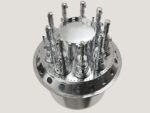Shield AI has unveiled a new autonomous combat drone capability based on its V-BAT vertical takeoff and landing (VTOL) platform. The company demonstrated a multi-drone teaming scenario powered by its Hivemind artificial intelligence pilot software—signaling a leap forward in autonomous operations within contested and denied environments.
V-BAT Teams: A New Paradigm in Autonomous Drone Operations
At the 2025 Association of the United States Army (AUSA) Annual Meeting in Washington D.C., Shield AI showcased what it calls “V-BAT Teams”—a concept involving multiple V-BAT drones operating autonomously under the control of onboard AI rather than human pilots or remote operators. The system is designed to function effectively even when GPS signals are jammed or communications are degraded.
The V-BAT is a Group 3 UAV with VTOL capability and a ducted fan design that allows it to hover like a helicopter but transition to fixed-wing flight for extended endurance. Each unit is equipped with Shield AI’s Hivemind software stack—a self-piloting system capable of real-time decision-making during missions such as ISR (intelligence, surveillance, reconnaissance), target acquisition, and strike coordination.
According to Brandon Tseng, Shield AI’s President and former Navy SEAL officer, “We’re not just flying one aircraft with autonomy—we’re flying multiple aircraft as a team conducting missions autonomously.”
Hivemind Software Enables GPS-Denied Autonomy
Central to the V-BAT Teams concept is Shield AI’s Hivemind software. Unlike traditional UAVs that rely on remote piloting or satellite navigation systems like GPS or GNSS for positioning and guidance, Hivemind enables fully autonomous flight through onboard perception and decision-making algorithms.
The system uses computer vision and sensor fusion from EO/IR cameras and inertial navigation systems (INS) to maintain situational awareness without external data links. This makes it particularly suited for operations in electronic warfare environments where GNSS spoofing or jamming is prevalent—a growing concern in peer conflict scenarios such as Ukraine or Taiwan contingencies.
Hivemind has already been integrated into various platforms beyond the V-BAT—including quadcopters and fixed-wing drones—and has logged thousands of autonomous flight hours across U.S. Department of Defense programs since 2018.
Modular Payloads Support ISR and Strike Roles
The V-BAT platform supports modular payload integration through its open architecture. It can carry EO/IR gimbals for day/night surveillance missions as well as synthetic aperture radar (SAR), electronic support measures (ESM), or even kinetic payloads depending on mission requirements.
- Endurance: Up to 11 hours depending on payload
- Range: Over 100 km operational radius
- Takeoff weight: ~57 kg (125 lbs)
- Crew required: None during flight; launch/recovery requires minimal ground support
This modularity allows the same airframe to be used across different mission sets—from persistent ISR over maritime areas to loitering munition roles in land warfare scenarios—without needing significant hardware changes.
Tactical Implications for Peer-Adversary Conflicts
The ability to deploy swarms or teams of autonomous drones without relying on satellite links represents a major shift in how airpower can be projected in denied environments. In recent conflicts such as Ukraine, both sides have demonstrated advanced EW capabilities that degrade traditional UAV effectiveness through jamming or spoofing.
The U.S. military has increasingly emphasized resilient C4ISR architectures that can operate under degraded conditions. Programs like DARPA’s OFFSET (Offensive Swarm-Enabled Tactics) and AFWERX’s Autonomy Prime have explored similar concepts—but Shield AI appears ahead in fieldable capability with operationally relevant platforms like the V-BAT.
If scaled effectively, autonomous drone teams could serve roles traditionally reserved for manned platforms—such as forward air control (FAC), battle damage assessment (BDA), or even suppression of enemy air defenses (SEAD)—but at lower cost and risk.
A Growing Role Within U.S. Defense Procurement
The Pentagon has shown increasing interest in attritable autonomous systems under initiatives like Replicator—a program launched by Deputy Secretary of Defense Kathleen Hicks aimed at fielding thousands of low-cost unmanned systems within two years. Shield AI’s technology aligns closely with this vision by offering scalable autonomy without requiring constant human oversight.
The company has secured contracts with multiple branches including SOCOM, Navy PMA-263 (UAS Program Office), and AFWERX SBIR/STTR programs. In July 2023, Shield AI announced a $60 million contract from the U.S. Air Force for continued development of Hivemind-enabled platforms.
This positions Shield AI as one of several key players—alongside Anduril Industries, Kratos Defense & Security Solutions, and General Atomics—in shaping next-generation unmanned combat aviation capabilities.
Outlook: Toward Fully Autonomous Air Dominance?
The unveiling of V-BAT Teams marks another step toward realizing truly autonomous aerial warfare capabilities that can operate independently across complex battlespaces. While regulatory hurdles remain—particularly around lethal autonomy—the trend toward teaming manned-unmanned assets is accelerating rapidly within NATO-aligned forces.
If successful at scale, these technologies could redefine force projection models by enabling persistent presence without risking pilots or relying on vulnerable satellite infrastructure—a critical advantage in future high-intensity conflicts against near-peer adversaries like China or Russia.










